![]()
Turner, John Mallord William (1775-1851). One of the finest landscape artists was J.M.W. Turner, whose work was exhibited when he was still a teenager. His entire life was devoted to his art. Unlike many artists of his era, he was successful throughout his career.
Joseph Mallord William Turner was born in London, England, on April 23, 1775. His father was a barber. His mother died when he was very young. The boy received little schooling. His father taught him how to read, but this was the extent of his education except for the study of art. By the age of 13 he was making drawings at home and exhibiting them in his father's shop window for sale.
Turner was 15 years old when he received a rare honor--one of his paintings was exhibited at the Royal Academy. By the time he was 18 he had his own studio. Before he was 20 print sellers were eagerly buying his drawings for reproduction.
He quickly achieved a fine reputation and was elected an associate of the Royal Academy. In 1802, when he was only 27, Turner became a full member. He then began traveling widely in Europe.
Venice was the inspiration of some of Turner's finest work. Wherever he visited he studied the effects of sea and sky in every kind of weather. His early training had been as a topographic draftsman. With the years, however, he developed a painting technique all his own. Instead of merely recording factually what he saw, Turner translated scenes into a light-filled expression of his own romantic feelings.
As he grew older Turner became an eccentric. Except for his father, with whom he lived for 30 years, he had no close friends. He allowed no one to watch him while he painted. He gave up attending the meetings of the academy. None of his acquaintances saw him for months at a time. Turner continued to travel but always alone. He still held exhibitions, but he usually refused to sell his paintings. When he was persuaded to sell one, he was dejected for days.
In 1850 he exhibited for the last time. One day Turner disappeared from his house. His housekeeper, after a search of many months, found him hiding in a house in Chelsea. He had been ill for a long time. He died the following day--Dec. 19, 1851.
Turner left a large fortune that he hoped would be used to support what he called "decaying artists." His collection of paintings was bequeathed to his country. At his request he was buried in St. Paul's Cathedral.
Although known for his oils, Turner is regarded as one of the founders of English watercolor landscape painting. Some of his most famous works are Calais Pier, Dido Building Carthage, Rain, Steam and Speed, Burial at Sea, and The Grand Canal, Venice.
 Dido building Carthage; or the Rise of the Carthaginian Empire
Dido building Carthage; or the Rise of the Carthaginian Empire
1815; Oil on canvas, 155.5 x 232 cm;
National Gallery, London
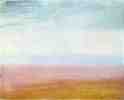 Colour Beginning
Colour Beginning
1819; Watercolor, 22.5 x 28.6 cm;
Tate Gallery, London
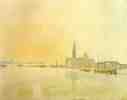 S. Giorgio Maggiore: Early Morning
S. Giorgio Maggiore: Early Morning
1819; Watercolor, 22.4 x 28.7 cm;
Tate Gallery, London
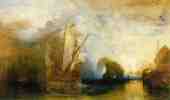 Ulysses deriding Polyphemus - Homer's Odyssey
Ulysses deriding Polyphemus - Homer's Odyssey
1829; Oil on canvas, 132.5 x 203 cm;
National Gallery, London
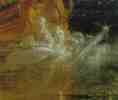 Ulysses deriding Polyphemus - Homer's Odyssey (detail)
Ulysses deriding Polyphemus - Homer's Odyssey (detail)
 Staffa, Fingal's Cave
Staffa, Fingal's Cave
1832; Oil on canvas, 90.9 x 121.4 cm;
Yale Center for British Art, New Haven
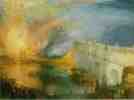 The Burning of the Houses of Lords and Commons, 16th October, 1834
The Burning of the Houses of Lords and Commons, 16th October, 1834
1835; Oil on canvas, 92 x 123 cm;
Philadelphia Museum of Art
 The Burning of the Houses of Lords and Commons, 16th October, 1834 (detail)
The Burning of the Houses of Lords and Commons, 16th October, 1834 (detail)
 The Grand Canal, Venice
The Grand Canal, Venice
1835; Oil on canvas, 91.4 x 122.2 cm;
The Metropolitan Museum of Art, New York
 Norham Castle, Sunrise
Norham Castle, Sunrise
c. 1835-40; Oil on canvas, 78 x 122 cm;
Clore Gallery for the Turner Collection, London
 Norham Castle, Sunrise (detail of cattle)
Norham Castle, Sunrise (detail of cattle)
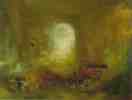 Interior at Petworth
Interior at Petworth
c. 1837; Oil on canvas, 91 x 122 cm;
Tate Gallery, London
 Interior at Petworth (detail 1)
Interior at Petworth (detail 1)
 Interior at Petworth (detail 2)
Interior at Petworth (detail 2)
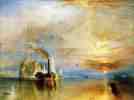 The Fighting "Temeraire" tugged to her last berth to be broken up
The Fighting "Temeraire" tugged to her last berth to be broken up
1838; Oil on canvas, 91 x 122 cm;
National Gallery, London
 The Fighting "Temeraire" tugged to her last berth to be broken up (detail)
The Fighting "Temeraire" tugged to her last berth to be broken up (detail)
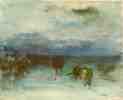 Moonlight
Moonlight
c. 1840; Watercolor with dabs of body color, 24.5 x 30.3 cm;
Tate Gallery, London
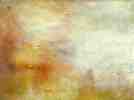 Sun Setting over a Lake
Sun Setting over a Lake
c. 1840; Oil on canvas, 91 x 122.5 cm;
Tate Gallery, London
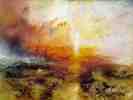 Slavers throwing overboard the Dead and Dying - Typhon coming on
("The Slave Ship")
Slavers throwing overboard the Dead and Dying - Typhon coming on
("The Slave Ship")
1840; Oil on canvas, 90.8 x 122.6 cm;
Museum of Fine Arts, Boston
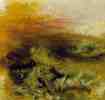 Slavers throwing overboard the Dead and Dying - Typhon coming on
("The Slave Ship") (detail)
Slavers throwing overboard the Dead and Dying - Typhon coming on
("The Slave Ship") (detail)
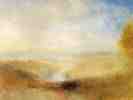 Landscape with Distant River and Bay
Landscape with Distant River and Bay
c. 1840-50; Oil on canvas, 94 x 124 cm;
Musée du Louvre, Paris
 Peace: Burial at Sea
Peace: Burial at Sea
1842; Oil on canvas, 86.9 x 86.6 cm;
Clore Gallery for the Turner Collection, London
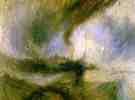 Snowstorm
Snowstorm
1842; Oil on canvas, 91.5 x 122 cm
 Shade and Darkness - the Evening of the Deluge
Shade and Darkness - the Evening of the Deluge
1843; Oil on canvas, 78.5 x 78 cm;
Tate Gallery, London
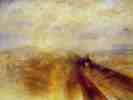 Rain, Steam and Speed
Rain, Steam and Speed
1844; Oil on canvas, 90.8 x 121.9 cm;
National Gallery, London
 Rain, Steam and Speed (detail of Locomotive)
Rain, Steam and Speed (detail of Locomotive)
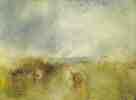 Procession of Boats with Distant Smoke, Venice
Procession of Boats with Distant Smoke, Venice
c. 1845; Oil on canvas, 90 x 120.5 cm;
Tate Gallery, London
 Sunrise with Sea Monsters
Sunrise with Sea Monsters
c. 1845; Oil on canvas, 91.5 x 122 cm;
Tate Gallery, London
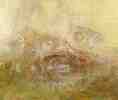 Sunrise with Sea Monsters (detail)
Sunrise with Sea Monsters (detail)
Photographs by Mark Harden.